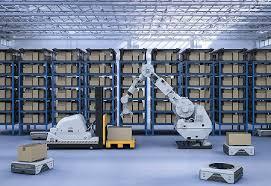Warehouse Automation Market: Recent Developments Fueling Industry Transformation

The warehouse automation market has seen unprecedented growth and transformation in recent years, driven by technological advancements, shifting consumer expectations, and the need for operational efficiency. As e-commerce continues to thrive, businesses are increasingly turning to automation solutions to streamline their operations, reduce costs, and enhance productivity. This article explores recent developments in the warehouse automation sector that are reshaping the industry landscape.
Technological Innovations
One of the most significant catalysts for change in the warehouse automation market is the rapid advancement of technology. Innovations in robotics, artificial intelligence (AI), and the Internet of Things (IoT) are playing pivotal roles in modernizing warehouse operations.
Robotics and Automated Systems
Robotic solutions have become more sophisticated, enabling warehouses to automate tasks such as picking, packing, and sorting. Autonomous Mobile Robots (AMRs) and Automated Guided Vehicles (AGVs) are increasingly being deployed to navigate through warehouses, transporting goods efficiently and reducing reliance on human labor. Recent developments in machine learning algorithms allow these robots to learn and adapt to their environment, improving their operational efficiency over time.
For instance, companies like Amazon and Walmart have invested heavily in robotic systems to optimize their supply chains. The introduction of robotic arms that can perform intricate tasks, such as picking items from shelves and packing them into boxes, exemplifies the advancements in this area. As these technologies become more accessible, small to medium-sized enterprises (SMEs) are also beginning to adopt automation solutions.
Artificial Intelligence and Data Analytics
AI is transforming warehouse management by providing real-time insights and predictive analytics. Warehouse management systems (WMS) integrated with AI can analyze vast amounts of data to forecast demand, optimize inventory levels, and enhance order fulfillment processes. Recent developments in AI-driven analytics allow businesses to identify trends and patterns that were previously undetectable, enabling better decision-making.
For example, AI algorithms can optimize the layout of a warehouse by analyzing the movement patterns of goods. This leads to more efficient storage solutions and minimizes the time workers spend locating products. Companies are increasingly using AI to improve safety measures, predicting potential hazards and allowing for proactive risk management.
E-commerce Growth and Consumer Expectations
The explosive growth of e-commerce, accelerated by the COVID-19 pandemic, has dramatically altered consumer expectations. Customers now demand faster delivery times and greater order accuracy, pressuring warehouses to enhance their operational capabilities. Recent developments in warehouse automation are directly addressing these challenges.
Same-Day and Next-Day Delivery
To meet consumer expectations for rapid delivery, warehouses are adopting automation solutions that facilitate quicker order processing. Automated sorting systems can significantly reduce the time it takes to fulfill orders, allowing businesses to offer same-day or next-day delivery options. Innovations in conveyor systems and high-speed sorting technology are making it possible for warehouses to handle increasing order volumes efficiently.
Additionally, the rise of micro-fulfillment centers—small, automated warehouses located closer to urban areas—has become a popular strategy for e-commerce companies. These centers utilize automation to streamline the picking and packing process, ensuring that orders are fulfilled swiftly and accurately.
Omnichannel Fulfillment
The need for seamless omnichannel fulfillment strategies has also fueled the demand for warehouse automation. Retailers are increasingly integrating their online and offline operations, requiring warehouses to handle orders from multiple channels. Recent developments in automated inventory management systems enable businesses to maintain accurate stock levels across all platforms, reducing the risk of stockouts and enhancing customer satisfaction.
Sustainability and Efficiency
As the global focus on sustainability intensifies, the warehouse automation market is responding with solutions that promote energy efficiency and reduce waste. Companies are investing in sustainable technologies to improve their environmental footprint while maintaining operational efficiency.
Energy-Efficient Technologies
Recent advancements in energy-efficient automation technologies, such as LED lighting, energy-saving conveyor systems, and smart HVAC systems, are becoming commonplace in warehouses. These solutions not only reduce energy costs but also align with corporate sustainability goals. Additionally, the use of electric-powered robots is on the rise, contributing to lower carbon emissions in warehouse operations.
Waste Reduction through Automation
Automation technologies also enable better inventory management, reducing waste through improved accuracy in order fulfillment. Automated systems can track inventory levels in real-time, minimizing excess stock and spoilage. This shift toward more sustainable practices is becoming a key differentiator for companies in the competitive warehouse automation market.
Conclusion
The warehouse automation market is undergoing a transformative shift fueled by recent developments in technology, changing consumer demands, and a growing emphasis on sustainability. As businesses continue to embrace automation solutions, they can achieve greater efficiency, enhance customer satisfaction, and remain competitive in an increasingly complex marketplace. The ongoing evolution of this industry promises to redefine the logistics landscape, paving the way for a more agile and responsive supply chain. As we look to the future, it is clear that warehouse automation will be a cornerstone of operational success in the years to come.
- Art
- Causes
- Crafts
- Dance
- Drinks
- Film
- Fitness
- Food
- Jogos
- Gardening
- Health
- Início
- Literature
- Music
- Networking
- Outro
- Party
- Religion
- Shopping
- Sports
- Theater
- Wellness


